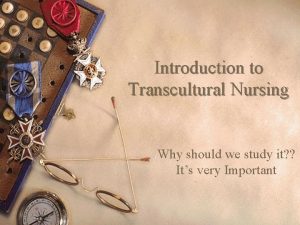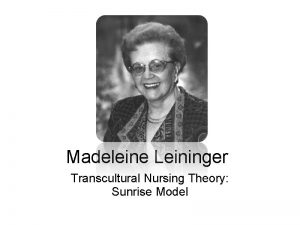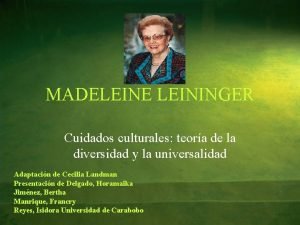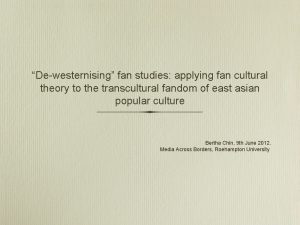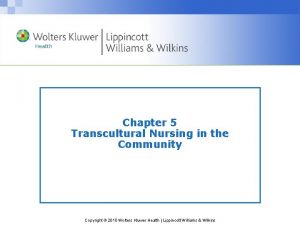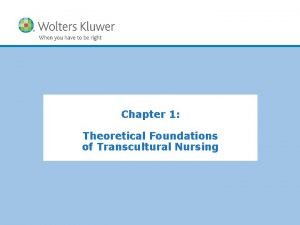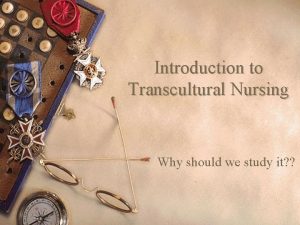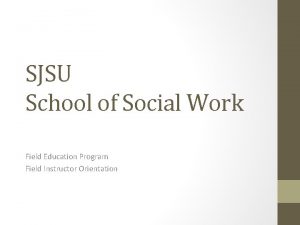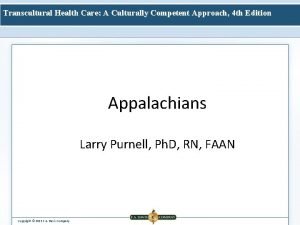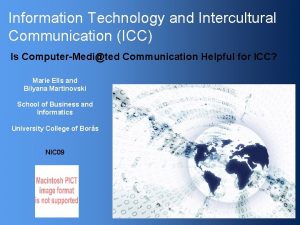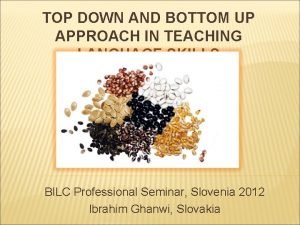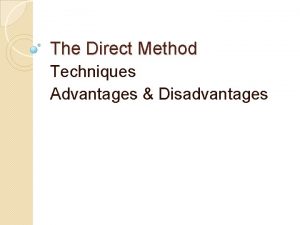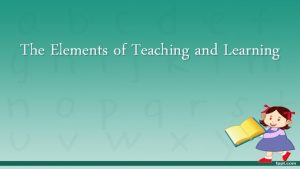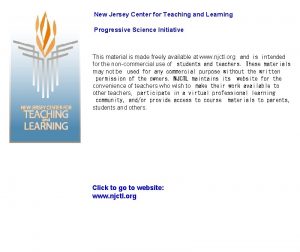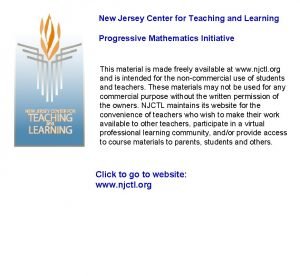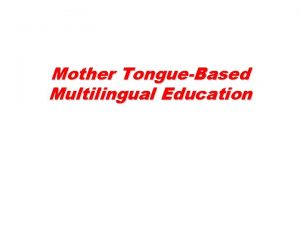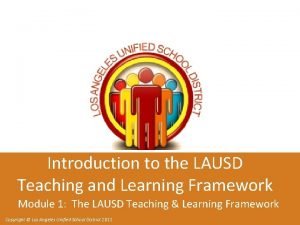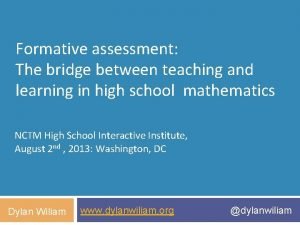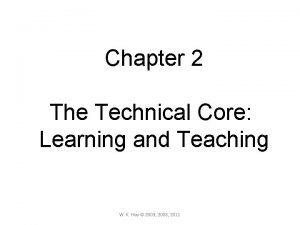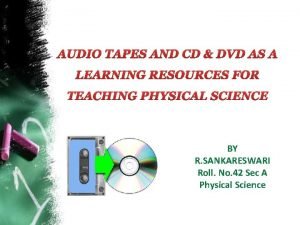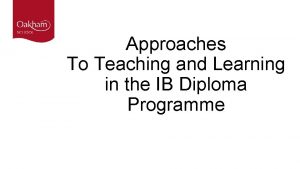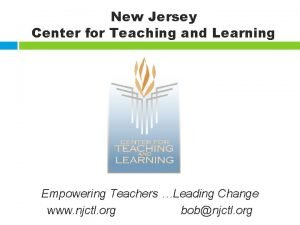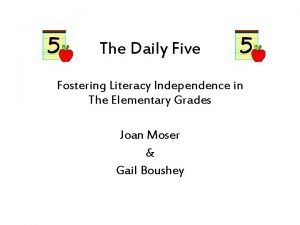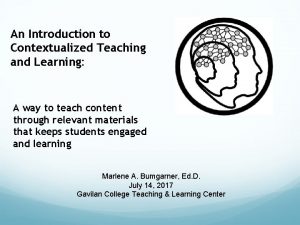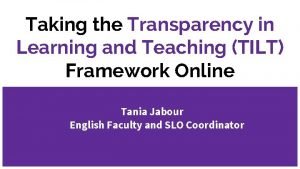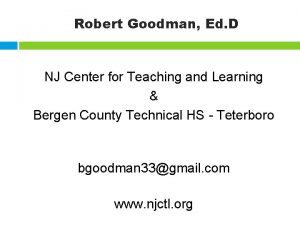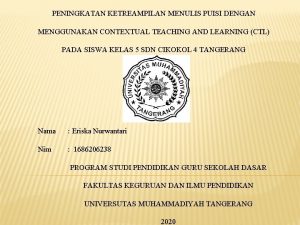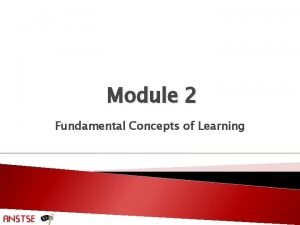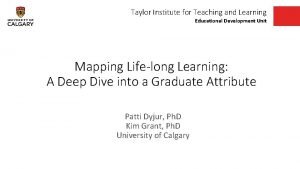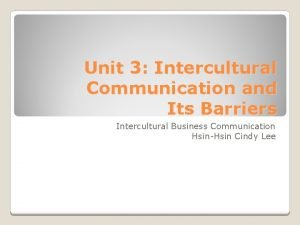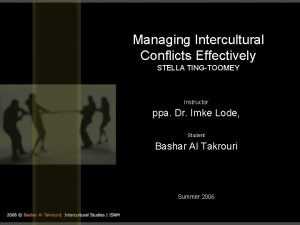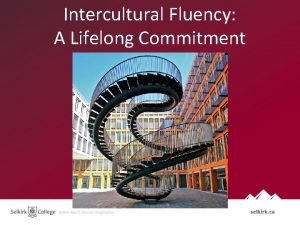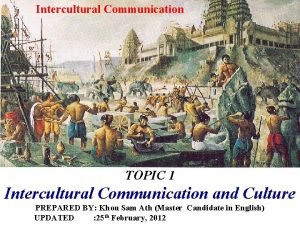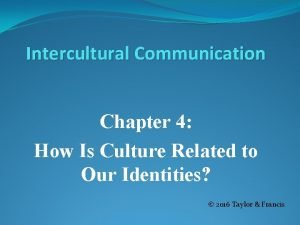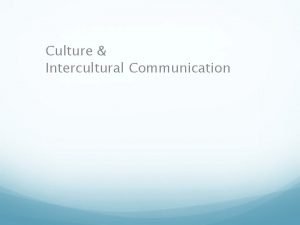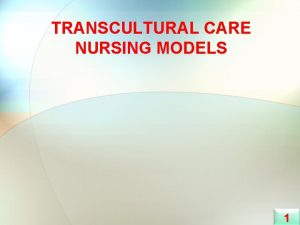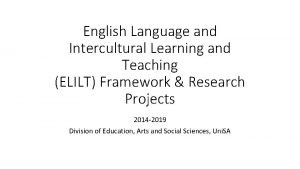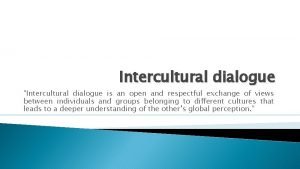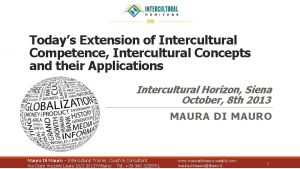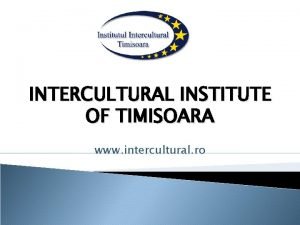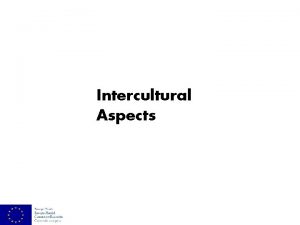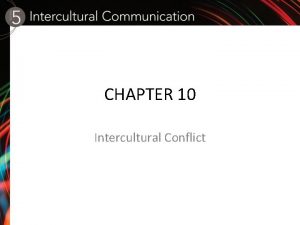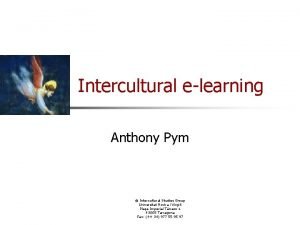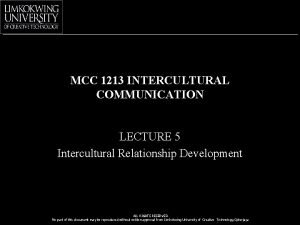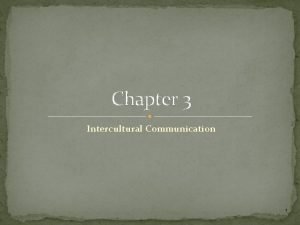Teaching English 7 Intercultural and transcultural learning Nancy









































- Slides: 41

Teaching English 7. Intercultural and transcultural learning Nancy Grimm – Michael Meyer – Laurenz Volkmann

1. From Landeskunde to intercultural learning 0. Table of contents 1. 1 Culture and language 1. 2 From Landeskunde to Cultural Studies and intercultural competence 1. 3 Concepts of intercultural competence 2. Toward transcultural competence 2. 1 Global issues and global education 2. 2 Assessing and evaluating inter- and transcultural competence 3. Ten principles 4. Recommended reading 5. Acknowledgements Chapter 7: Intercultural and transcultural learning 2

Discuss: Consider the cartoon together with the following statement: “If you get the present perfect and the simple past wrong you may lose marks; if you get the culture wrong you may lose face, money or even life. ” (Gibson 1994: 127) Discuss why the intercultural encounter depicted in the cartoon goes wrong. Which assumptions lead to particular perspectives and problems? How could one avoid the blunders shown in the cartoon? Chapter 7: Intercultural and transcultural learning 3

1. 1 Culture and language – language creates mental images Consider the following two sentences: ‘It was at the end of November. Grandpa brought the bird to the table. ’ Imagine the scene and discuss how the story would continue. 1. From Landeskunde to intercultural learning Oven-roasted turkey Domestic canary ‘Dirty old man’ Young lady Senior citizen 4

1. 1 Culture and language Sapir-Whorf Hypothesis: formative power of words or languages on how individuals construct their environment Ø nowadays, scholars favor more complex models of how reality is created by and in languages We [English speakers] have the same word for falling snow, snow on the ground, snow hard packed like ice, slushy snow, wind-driven snow – whatever the situation may be. To an Eskimo, this allinclusive word would be almost unthinkable […]. Whorf in Carroll 1956: 216 1. From Landeskunde to intercultural learning 5

1. 1 Culture and language Teaching language without culture? Ø We are all ‘the same under the skin’!? 1. From Landeskunde to intercultural learning Lingua franca-approach general rules of politeness and conversation strategies list of Do’s and Don’ts More comprehensive educational goals language and communication always inflected by national identities + regions, ethnicities, social classes, etc. 6

1. 1 Culture and language If a British student asks for a ‘rubber, ’ why is his American fellow student irritated? “Imagine there’s no heaven, above us only skies. ” (John Lennon) Why difficult to translate? Is a ‘friend’ on Facebook really what you would consider a ‘Freund’ in Germany? In Delhi, you see signs for a ‘hotel. ’ Can you stay there overnight? Why are Americans taken aback if you ask for the ‘toilet’? What is a ‘black eye’? What do Americans and Europeans associate with the term ‘capitalism’? Can you use the expression ‘negro’ for an African American? 1. From Landeskunde to intercultural learning 7

1. 2 From Landeskunde to Cultural Studies and intercultural competence Landeskunde / area, regional, background studies (1950 s 1980 s) Kulturkunde (late 19 th century) Wesenskunde with a strong nationalist bias (1933 -1945) 1. From Landeskunde to intercultural learning Intercultural Learning / Cultural Studies (1980 snow) 8

1. 2 From Landeskunde to Cultural Studies and intercultural competence Area/background studies (Landeskunde): a problematic concept Vague agenda: ‘Völkerverständigung’ ‘Culture with a capital C, ’ facts & figures Target cultures: positive / neutral 1. From Landeskunde to intercultural learning ‘Tourist kit’approach Idealized social images 9

1. 2 From Landeskunde to Cultural Studies and intercultural competence Area/background studies (Landeskunde): a problematic concept Codes of behavior History Geograp hy, regionnalism Minoriti es Religion, ideologi es, ‘creeds’ 1. From Landeskunde to intercultural learning Uses of language Art Topics covered Science Economi cs Political institutio ns Social structur e 10

1. 2 From Landeskunde to Cultural Studies and intercultural competence – a forceful shift Notion of culture open wide-ranging shifting, flexible Culture shapes the life of humans is shaped by them inclusive concept Target cultures Anglophone countries, areas intercultural exchanges English as lingua franca 1. From Landeskunde to intercultural learning 11

1. 2 From Landeskunde to Cultural Studies and intercultural competence Cultural Studies as cultural counter-discourse Pragmatic intercultural learning § Introduced in the 1960 s and 1970 s: Raymond Williams, Richard Hoggart, E. P. Thompson § Originated in multicultural societies such as the USA, first conceptualized in the 1960 s as intracultural learning Ø Ø empowerment of the working classes, ethnic minority groups developing a counter-hegemonic perspective from literature to films and products of popular culture attention to the production, composition, reception, circulation of cultural practices 1. From Landeskunde to intercultural learning Ø learning to live together in multicultural and multiethnic communities Ø learning about habits, norms, values, taboos, etc. Ø international business communication: ‘cultural norms’ more effective and friction-free, avoid social blunders and detrimental faux pas; Do’s and Don’ts 12

1. 2 From Landeskunde to Cultural Studies and intercultural competence Intercultural learning in the EFL classroom Integral part 1. From Landeskunde to intercultural learning Various contexts Tolerance, understanding, solidarity 13

1. 2 From Landeskunde to Cultural Studies and intercultural competence PI Fremdverstehen (Bredella 2010) Redefinition of cultural learning intercultural processes of meaning creation 1. From Landeskunde to intercultural learning ‘Negotiation of meaning’ (Bedeutungsaushandlung) P-wechsel Pübernahme Pkoordination students as selfreflective coconstructors of cultural meanings P II comparison of horizons rather than blending of such horizons 14

1. 3 Concepts of intercultural competence Critical awareness and reflexivity Tolerance, openness, respect, willingness own cultural preconditioning & to accept the cultural members of conditionings other cultures of others on their own terms Readiness to meet with others Action competence in the interstices between two cultures: third place, ‘culture of a third kind’ (Kramsch 1998) to engage in communicative acts while being aware of unwritten rules & norms which shape intercultural encounters Freese 2002: 15, slightly adapted 1. From Landeskunde to intercultural learning 15

1. 3 Concepts of intercultural competence The ‘iceberg model’ of culture: Ø national cultures ‘produce’ different cultural icebergs, which shape and form the individual’s mind-set (cf. Gibson 2000: 16) pork carp Gibson 2000: 16, adapted 1. From Landeskunde to intercultural learning 16

1. 3 Concepts of intercultural competence Cultural phenomena baseball cap cross necklace Gibson 2000: 16, adapted 1. From Landeskunde to intercultural learning 17

1. 3 Concepts of intercultural competence Power distance Uncertainty avoidance Individualism vs. collectivism Masculinity vs. femininity 1. From Landeskunde to intercultural learning Gibson 2000: 16, adapted 18

Ask students to search the Internet for a collection/list of Do’s and Don’ts for Germany: ask them to compile a list of tips and present them in class. Discuss if they are true and what they tell you about the writer’s cultural background. 1. From Landeskunde to intercultural learning 19

1. 3 Concepts of intercultural competence Critical incidents What went wrong? Analyze different cultural beliefs and attitudes Discuss ways of avoiding cultural conflict Simulation Outsourced, 2006 1. From Landeskunde to intercultural learning 20

1. 3 Concepts of intercultural competence Critical incidents What went wrong? Analyze different cultural beliefs and attitudes Discuss ways of avoiding cultural conflict Simulation Outsourced, 2006 1. From Landeskunde to intercultural learning A German manager working in Thailand is unhappy that his secretary arrives at work at least 30 minutes, and sometimes as much as one hour, late for work. He knows that the traffic in Bangkok is bad but this is getting ridiculous – one morning when she arrives he explodes in front of the others in the busy office, and then takes her aside and tells her that if she can’t get to work on time she may risk losing her job. She hands in her resignation. Gibson 2000: 43 21

1. 3 Concepts of intercultural competence National stereotypes: Ø ‘images of the mind’ Ø “necessary overgeneralizations and oversimplifications that are rigid, resistant to change, undependable in their actual content, produced without logical reasoning” (Lippmann in Hammer 2012: 23) 1. From Landeskunde to intercultural learning Consider the following intercultural questions. Discuss them with fellow students, also from another cultural background. In addition, discuss the attitudes behind cultural or communicative practices. In your culture or when in a certain country … Ø Is it considered correct to interrupt someone who is speaking and, if so, when is it permissible? Ø How do you begin a conversation with someone you have never met before? Ø How long do you maintain eye contact when talking with or listening to someone? Ø What is the body distance you feel comfortable with when talking to someone you do not know? 22

2. 1 Global issues and global education Tolerance, intercultural dialogue and respect for diversity are more essential than ever in a world where peoples are becoming more and more closely interconnected. – Kofi Annan 2. Toward transcultural competence 23

2. 1 Global issues and global education Global diseases Acid rain Violence, exploitatio n, suppressio n Population growth Global warming Genocide, famines refugees cf. Hammer 2012: 62 2. Toward transcultural competence 24

2. 1 Global issues and global education language demographic social health peace Topics covere Aspects d media rights technic al politica l socioeconomic 2. Toward transcultural competence cultural ecological cf. Volkmann 2010: 195 -96, Hammer 2012: 75 25

2. 1 Global issues and global education – teaching goals Be aware of your responsibility to further international understanding through your teaching. Increase language teaching effectiveness so as to enhance mutual respect, peaceful coexistence, and cooperation among nations. Exploit Lay extracurricular activities such as pen-pal programs, video exchanges, and overseas excursions to develop international understanding. the basis for international cooperation through classroom cooperation using language-teaching approaches responsive to students’ interests and needs. Hammer 2012: 63 -64 2. Toward transcultural competence 26

2. 1 Global issues and global education Loss of clearly defined target cultures and key issues Problems Highlighting too many topics without specific national, regional, historical foci risk: superficiality 2. Toward transcultural competence English might lose content as a school subject risk: ‘meta-subject’ without a clear agenda 27

2. 1 Global issues and global education – ecodidactics interconnecte d-ness Creating complexity / fragility of biosystems Topics covered wholeness, sustainability, diversity Furthering Empowering Changing ecological knowledge understanding of sustaining natural resources and the environment learners to deal with nature and natural resources more responsibly consumer habits ? ? ? Western creed of technology? ? ? cf. Mayer & Wilson 2006 2. Toward transcultural competence 28

Discuss: Try to describe the contradiction presented here and why this is not a single, isolated incident. Think of how it could be exemplary of similar double-bind situations we all are faced with. Consider possible ways of getting out of this double-bind. How can you get students to write similar poems – and how can they discuss possible strategies of escaping the double bind? 2. Toward transcultural competence Julia Damassa: “Green” (1989) Outside the supermarket sign the petition ‘SAVE OUR EARTH’. Feel a momentary sense of achievement as you turn the ignition. qtd. in Volkmann 2012: 405 29

2. 2 Assessing and evaluating inter- and transcultural competence Byram 1997: 49 -55, as adapted by Coperías-Aguilar 2007: 64 2. Toward transcultural competence 30

2. 2 Assessing and evaluating inter- and transcultural competence Knowledge students know of… target cultures and their sub-cultures, their local and global importance, see problems, challenges, and opportunities the historical and social background and possible solutions of cultural phenomena; how they differ from those known to them and how they relate to them 2. Toward transcultural competence 31

2. 2 Assessing and evaluating inter- and transcultural competence Skills students can… identify and explain cultural phenomena, critically reflect on them, and apply their skills to similar topics relate to problems and challenges presented to them cognitively, tackle them in a creative, cooperative way and weigh possibilities of solving problems or crises; they can weigh issues considering several perspectives, and they can assess culture-specific and transcultural elements 2. Toward transcultural competence 32

2. 2 Assessing and evaluating inter- and transcultural competence motivated to find out more about the target culture(s) and the issues presented aware of the problems and chances inherent in the issue at hand Attitudes students are… aware of their own and other approaches to defining the cultural phenomenon under discussion and ready to compare them more open toward the other culture, respect fairness, social justice, diversity, complexity, ambiguity, and develop empathy encouraged to act (verbally) according to the principle of ‘think globally, act locally’ 2. Toward transcultural competence 33

Have another look at the cartoon. Try to define the teaching and learning objectives according to Byram with regard to the dialog presented in the cartoon. What knowledge, skills, and attitudes can students acquire? What overall educational objective would you aim at? 1. From Landeskunde to intercultural learning 34

3. Ten principles From knowledge transfer to acquiring cultural competence From canonical knowledge to exemplary learning From the outside perspective to a multiperspectival approach From the concept of a ‘neutral’ learner to a focus on learner identity From culture to cultures cf. Nünning & Nünning 2000, Teske 2006, Volkmann 2010 3. Ten principles 35

3. Ten principles Finding the right cultural mix Toward a holistic approach: integrating culture and language learning Representing cultures via various texts and media Considering balanced representations Toward student-centeredness cf. Nünning & Nünning 2000, Teske 2006, Volkmann 2010 3. Ten principles 36

Recommended reading Byram, Michael (1997). Teaching and Assessing Intercultural Communicative Competence. Clevedon et al. : Multilingual Matters. Eisenmann, Maria; Nancy Grimm & Laurenz Volkmann, eds. (2010). Teaching the New English Cultures and Literatures. Heidelberg: Winter. Hammer, Julia (2012). Die Auswirkungen der Globalisierung auf den modernen Fremdsprachenunterricht: Globale Herausforderungen als Lernziele und Inhalte des fortgeschrittenen Englischunterrichts – Are We Facing the Future? Heidelberg: Winter. Kramsch, Claire (1998). Language and Culture. Oxford et al. : Oxford University Press. Teske, Doris (2006). Cultural Studies: Key Issues and Approaches. In: Werner Delanoy & Laurenz Volkmann, eds. Cultural Studies in the EFL Classroom. Heidelberg: Winter, 23 -33. Volkmann, Laurenz (2010). Fachdidaktik Englisch: Kultur und Sprache. Tuebingen: Narr. Volkmann, Laurenz (2014). Die Abkehr vom Differenzdenken: Transkulturelles Lernen und global education. In: Frauke Matz; Michael Rogge & Philipp Siepmann, eds. Transkulturelles Lernen im Fremdsprachenunterricht: Theorie und Praxis. Frankfurt a. M. : Lang: 37 -51. Chapter 7: Intercultural and transcultural learning 37

Acknowledgments Bredella, Lothar (2010). Das Verstehen des Anderen: Kulturwissenschaftliche und literaturdidaktische Studien. Tuebingen: Narr. Byram, Michael (1997). Teaching and Assessing Intercultural Communicative Competence. Clevedon et al. : Multilingual Matters. Carroll, John B. , ed. (1956). Language, Thought, and Reality: Selected Writings of Benjamin Lee Whorf. Cambridge: M. I. T. Press, 207 -219. Coperías-Aguilar, Maria José (2007). Dealing with Intercultural Communicative Competence in the Foreign Language Classroom. In: Eva Alcón Soler & Maria Pilar Safont Jorda, eds. Intercultural Language Learning and Language Use. Dordrecht: Springer, 58 -78. Freese, Peter (2002). The Chances and Limits of ‘Intercultural Understanding’ in the Advanced EFL-Classroom. In: Teaching ‘America’: Selected Essays. Munich: Langenscheidt. Longman, 11 -30. Gibson, Robert (1994). The Intercultural Dimension: Hidden Differences between British Culture and Other Cultures. In: Fremdsprachenunterricht 38. 2, 127 -29. Gibson, Robert (2000). Intercultural Business Communication: Fachsprache Englisch. Berlin: Cornelsen. Chapter 7: Intercultural and transcultural learning 38

Acknowledgments Hammer, Julia (2012). Die Auswirkungen der Globalisierung auf den modernen Fremdsprachenunterricht: Globale Herausforderungen als Lernziele und Inhalte des fortgeschrittenen Englischunterrichts – Are We Facing the Future? Heidelberg: Winter. Mayer, Sylvia & Graham Wilson, eds. (2006). Ecodidactic Perspectives on English Language, Literatures and Cultures. Trier: WVT. Nünning, Vera & Ansgar Nünning (2000). British Cultural Studies konkret: 10 Leitkonzepte für einen innovativen Kulturunterricht. In: Der fremdsprachliche Unterricht Englisch 43. 1, 4 -9. Teske, Doris (2006). Cultural Studies: Key Issues and Approaches. In: Werner Delanoy & Laurenz Volkmann, eds. Cultural Studies in the EFL Classroom. Heidelberg: Winter, 23 -33. Volkmann, Laurenz (2010). Fachdidaktik Englisch: Kultur und Sprache. Tuebingen: Narr. Volkmann, Laurenz (2012). Ecodidactics als Antwort auf die planetare Bedrohung? Zum Einsatz von ecopoetry im Englischunterricht. In: Rüdiger Ahrens; Maria Eisenmann & Julia Hammer, eds. Literatur im Interkulturellen Kontext – Zukunftsperspektiven für den Englischunterricht. Heidelberg: Winter, 393 -408. Chapter 7: Intercultural and transcultural learning 39

Acknowledgments The cartoons at the beginning of each ppt were designed by Frollein Motte, 2014. If not otherwise indicated, the copyright of the figures lies with the authors. The complete titles of the sources can be found in the references to the units unless given below. All of the websites were checked on 10 September 2014. § Slide 4: https: //en. wikipedia. org/wiki/Thanksgiving#/media/File: Roast. Turkey. jpg, https: //en. wikipedia. org/wiki/Domestic_canary#/media/File: Canario_photo. jpg, https: //commons. wikimedia. org/wiki/File: Young_Girl. jpg? uselang=de#/media/File: Young_Girl. jpg, https: //pixabay. com/en/old-man-standing-senior-adult-23730, https: //pixabay. com/en/grandfather-bald-head-bald-patch-153659 § Slide 5: https: //pixabay. com/en/cloud-snow-flakes-winter-weather-306404 § Slide 7: https: //pixabay. com/en/eraser-rubber-red-undo-office-307519, https: //pixabay. com/en/trail-airplane-blue-sky-109114, https: //pixabay. com/en/thumbfacebook-hand-like-font-533233, https: //pixabay. com/es/wc-de-papel-rosa-higiene-rodillo 30328, https: //pixabay. com/de/smiley-emoticon-smiles-emotion-150838, https: //pixabay. com/en/currencies-world-earth-map-cent-64275, https: //pixabay. com/en/boykids-human-little-african-37001 § Slides 13 & 15: Schwebender Globus in einem Büro der Universität Jena, aufgenommen am 29. 04. 2013. Foto: Jan-Peter Kasper/FSU; Willkommen-Banner am 10. 2012 an der Mensa auf dem Campus der Universität Jena am Ernst-Abbe-Platz. Foto: Jan-Peter Kasper/FSU Chapter 7: Intercultural and transcultural learning 40

Acknowledgments § Slides 16 & 17: https: //de. wikipedia. org/wiki/Hausschwein#/media/File: Sow_with_piglet. jpg, https: //en. wikipedia. org/wiki/Carp#/media/File: Cyprinus_carpio. jpeg, https: //commons. wikimedia. org/wiki/Category: Baseball_caps#/media/File: Snapback_Hat. jpg, https: //en. wikipedia. org/wiki/Cross_necklace#/media/File: Krest_yuri_fedorov. jpg § Slides 20 & 21: http: //www. impawards. com/2007/outsourced_ver 4. html, https: //en. wikipedia. org/wiki/India#/media/File: Flag_of_India. svg, https: //en. wikipedia. org/wiki/United_States#/media/File: Flag_of_the_United_States. svg § Slides 23 & 25: https: //pixabay. com/en/group-person-alltogether-157476 § Slide 24: https: //pixabay. com/en/ice-cubes-ice-cold-melting-blue-48867, https: //pixabay. com/en/heavy-rain-foggy-cloudy-rainy-98539, https: //pixabay. com/en/person-silhouettes-human-540257, https: //pixabay. com/en/biohazardinfected-infection-549303, https: //pixabay. com/de/team-menschen-teamarbeit-gruppe-23885, https: //en. wikipedia. org/wiki/Child_labour#/media/File: Diamond_miners-1 -. jpg § Slide 28: https: //pixabay. com/en/earth-world-globe-ecology-159132 § Slide 29: https: //de. wikipedia. org/wiki/Erde#/media/File: The_Earth_seen_from_Apollo_17. jpg § Slide 36: https: //de. wikipedia. org/wiki/Eichh%C 3%B 6 rnchen#/media/File: Eichh%C 3%B 6 rnchen_im_Herbst. jpg Chapter 7: Intercultural and transcultural learning 41
 Culturally congruent care definition
Culturally congruent care definition Leininger nursing theory
Leininger nursing theory Fuentes teoricas de madeleine leininger
Fuentes teoricas de madeleine leininger Towards a theory of transcultural fandom
Towards a theory of transcultural fandom Transcultural nursing questions
Transcultural nursing questions Theoretical foundations of transcultural nursing
Theoretical foundations of transcultural nursing Patricia enciso
Patricia enciso Transcultural perspective sjsu
Transcultural perspective sjsu Transcultural health care
Transcultural health care Transcultural health care definition
Transcultural health care definition Macro teaching is a scaled down teaching
Macro teaching is a scaled down teaching Cuadro comparativo entre e-learning b-learning y m-learning
Cuadro comparativo entre e-learning b-learning y m-learning Technology and intercultural communication
Technology and intercultural communication Top down approach teaching
Top down approach teaching Direct teaching method advantages disadvantages
Direct teaching method advantages disadvantages Direct approach in teaching language
Direct approach in teaching language What are the elements of teaching and learning
What are the elements of teaching and learning New jersey center for teaching and learning
New jersey center for teaching and learning New jersey center for teaching and learning
New jersey center for teaching and learning Guiding principles for teaching and learning in mtb-mle pdf
Guiding principles for teaching and learning in mtb-mle pdf Teaching and learning framework lausd
Teaching and learning framework lausd Assessment the bridge between teaching and learning
Assessment the bridge between teaching and learning Technical core meaning
Technical core meaning Advantages and disadvantages of tape recorder in education
Advantages and disadvantages of tape recorder in education Affective skills ib
Affective skills ib Www.njctl.org answer key
Www.njctl.org answer key 10 steps to teaching and learning independence
10 steps to teaching and learning independence What is assure model
What is assure model What is contextualized teaching and learning
What is contextualized teaching and learning Tilt assignment template
Tilt assignment template Nj center for teaching and learning
Nj center for teaching and learning Contextual teaching and learning
Contextual teaching and learning Types of learning
Types of learning Taylor institute for teaching and learning
Taylor institute for teaching and learning Stereotype barrier in communication
Stereotype barrier in communication Stella ting toomey
Stella ting toomey Kyra garson
Kyra garson Intercultural conflict definition
Intercultural conflict definition Example of a low context culture
Example of a low context culture Questions about intercultural communication
Questions about intercultural communication Avowal and ascription example
Avowal and ascription example Youtube intercultural communication
Youtube intercultural communication
